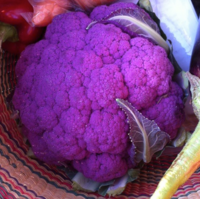
Photo from wikipedia
Abstract The worldwide problem of food loss and recent outbreaks of food-related diseases caused by microbial contamination has highlighted the urgent need of efficient preservation methods. Plants of Brassicaceae familyare… Click to show full abstract
Abstract The worldwide problem of food loss and recent outbreaks of food-related diseases caused by microbial contamination has highlighted the urgent need of efficient preservation methods. Plants of Brassicaceae familyare particularly rich in compounds with antiviral, antimicrobial and anticancer properties. Herein, a water-soluble extract of broccoli (Brassica oleracea var. italica) seeds showed strong antifungal activity against fungal food contaminants. A 15-kDa polypeptide was selectively extracted with ammonium sulphate precipitation, ion-exchange and size exclusion chromatography Circular dichroism spectroscopy and analysis of broccoli seed transcriptome revealed high similarity to the previously isolated rapessed storage protein napins. This paper is the first report of the isolation and characterization of napin-like proteins from broccoli seedsIn addition, apH-dependent approach was used to increase the yield of extraction with a minimal use of chemicals. The potential of the broccoli napin, termed BoNap, as a novel antifungal agent was shown in in vitro assays against the spores of several fungal contaminants. BoNap prevented the germination of spores of Fusarium culmorum and Penicillium expansum, with a MIC value of 2.31 μM. In addition, the napin-like protein presented an arsenal of mechanisms for the protection of the seeds, including permeabilization of mycelium membrane and trypsin-inhibitory properties. Essential characteristics of heat stability and non-cytotoxicity towards mammalian cells highlight the promises of this compound in the area of food safety and crop protection. As shown here with a successful reduction of fungal contamination of cereals, the discovery of a readily extractable plant protein could contribute to its application as a natural stable preservative and to limit the global issue of food waste.
Journal Title: Food Control
Year Published: 2020
Link to full text (if available)
Share on Social Media: Sign Up to like & get
recommendations!